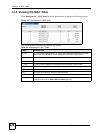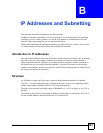
Appendix A Product Specifications
ES-2024 Series User’s Guide
236
Console Port D-Sub 9 pin Female (DCE)
System Monitoring Voltage:
1.25 V: +/- 6%
1.8 V: +/- 6%
3.3 V: +/- 6%
2.5 V: +/- 6%
Temperature:
CPU: 60 degrees C
MAC: 60 degrees C
Fan Speed: 3500~8000 rpm
Table 98 Feature Descriptions
FEATURE DESCRIPTION
VLAN A VLAN (Virtual Local Area Network) allows a physical network to be
partitioned into multiple logical networks. Devices on a logical network
belong to one group. A device can belong to more than one group. With
VLAN, a device cannot directly talk to or hear from devices that are not
in the same group(s); the traffic must first go through a router.
MAC Address Filter Filter traffic based on the source and/or destination MAC address and
VLAN group (ID).
DHCP (Dynamic Host
Configuration Protocol)
Use this feature to have the relay DHCP requests to DHCP servers on
your network.
IGMP Snooping The Switch supports IGMP snooping enabling group multicast traffic to
be only forwarded to ports that are members of that group; thus allowing
you to significantly reduce multicast traffic passing through your Switch.
Differentiated Services
(DiffServ)
With DiffServ, the Switch marks packets so that they receive specific
per-hop treatment at DiffServ-compliant network devices along the route
based on the application types and traffic flow.
Queuing Queuing is used to help solve performance degradation when there is
network congestion. Three scheduling services are supported: Strict
Priority Queuing (SPQ) and Weighted Round Robin (WRR). This allows
the Switch to maintain separate queues for packets from each individual
source or flow and prevent a source from monopolizing the bandwidth.
Port Mirroring Port mirroring allows you to copy traffic going from one or all ports to
another or all ports in order that you can examine the traffic from the
mirror port (the port you copy the traffic to) without interference.
Static Route Static routes tell the Switch how to forward IP traffic when you configure
the TCP/IP parameters manually.
Multicast VLAN Registration
(MVR)
Multicast VLAN Registration (MVR) is designed for applications (such as
Media-on-Demand (MoD)) using multicast traffic across a network. MVR
allows one single multicast VLAN to be shared among different
subscriber VLANs on the network.
This improves bandwidth utilization by reducing multicast traffic in the
subscriber VLANs and simplifies multicast group management.
STP (Spanning Tree
Protocol) / RSTP (Rapid
STP) / MSTP (Multiple STP)
(R)STP detects and breaks network loops and provides backup links
between switches, bridges or routers. It allows a Switch to interact with
other (R)STP-compliant switches in your network to ensure that only one
path exists between any two stations on the network. The Switch also
allows you to set up multiple STP configurations (or trees). Ports can
then be assigned to the trees.
Loop Guard Use the loop guard feature to protect against network loops on the edge
of your network.
Table 97 Hardware Specifications (continued)
SPECIFICATION DESCRIPTION


















